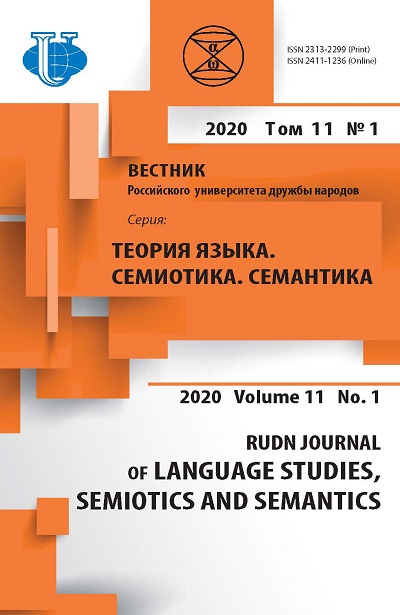An analytical study of word-order patterns in Standard Arabic simple sentence
- Authors: Ghomri T.1, Souadkia M.2
-
Affiliations:
- Tahri Mohamed University
- Peoples’ Friendship University of Russia (RUDN University)
- Issue: Vol 11, No 1 (2020)
- Pages: 78-91
- Section: FUNCTIONAL GRAMMAR AND SEMANTICS
- URL: https://journals.rudn.ru/semiotics-semantics/article/view/23044
- DOI: https://doi.org/10.22363/2313-2299-2020-11-1-78-91
- ID: 23044
Cite item
Full Text
Abstract
The main focus of the study is to analyze the simple sentence structure and its word-order patterns of Standard Arabic syntactically. Main methods concern description and comparison of word-order patterns observed. Primarily the current study deals with some differentiations of the terms on sentence types and word-order patterns described by both medieval grammarians and modern linguists. Moreover, the so called Sībawayhian theory of ʿamil’ also provides some explanations of sentence structures and word-order patterns in Standard Arabic. Simple sentences are highlighted to examine the occasions for using different patterns and where they are commonly found, along with examples to facilitate the explanation and use of these patterns. It is essential to point out that Standard Arabic is considered to be a language with a flexible word-order, which is why there exist word-order patterns of both VOS and SVO languages, though the latter is more frequently used.
About the authors
Tedj Ghomri
Tahri Mohamed University
Email: ghomritedj@gmail.com
Dr. Head of the Department of Foreign Languages 714, Independence Road, Bechar, Algeria, 08000
Mounya Souadkia
Peoples’ Friendship University of Russia (RUDN University)
Email: mounya.sdkia@gmail.com
third year PhD student of the General and Russian Linguistics Department, Philological Faculty 6, Miklukho-Maklaya str., Moscow, Russian Federation, 117198
References
- Peled, Y. (2009). Sentence Types and Word-Order Patterns in Written Arabic: Medieval and Modern Perspectives. Brill Academic Pub Edited by T. Muraoka and C.H.M. Versteegh, Studies in Semitic Languages and Linguistics, 52. Leiden. URL: https://books.google.ru/ books?hl=en&lr=&id=xNWvCQAAQBAJ&oi=fnd&pg=PR11&dq=related:mxy7RcAJfvefp M:scholar.google.com/&ots=1VERVczBb-&sig=QdSuUtOrgFhO_bswZJgMZPvF3PE& redir_esc=y#v=onepage&q&f=false (accessed: 18.03.2019).
- Souadkia, M. (2017). Comparative Study of Word-order Patterns of Simple Sentences in English and Arabic, RUDN Journal of Language Studies, Semiotics and Semantics, 8(2), 485-493.
- Greenberg, J.H. (1966). Some Universals of Grammar with Particular Reference to the Order of Meaningful Elements. Stanford: Stanford University. pp. 58-90. URL: http://www.fb10.unibremen.de/homepages/hackmack/syntax/pdf/Universals_of_Language.pdf (accessed: 20.03.2019).
- Trask, R.L. (1993). A Dictionary of Grammatical Terms in Linguistics. Psychology Press. London and New York: Routledge. URL: https://books.google.ru/books?id=rcT62Lpcoc8C&pg= PA251&lpg=PA251&dq=larry+trask+sentence+type+one+of+the+four+traditional&source=bl&ots=j vvCyyf48K&sig=ACfU3U2HfEh71Um1O6ogZGQ9mHBevG1D2Q&hl=en&sa=X&ved=2ahUKE wj6zP6mh-zkAhUOmIsKHRsRCXYQ6AEwAHoECAQQAQ#v=onepage&q=larry%20trask% 20sentence%20type%20one%20of%20the%20four%20traditional&f=false (accessed: 17.03.2019).
- Cantarino, V. (1974). Syntax of Modern Arabic Prose: the Simple Sentence. London: Indiana University Press. Vol. 1. URL: https://archive.org/details/SyntaxOfModernArabicProseSMAP1/ page/n7 (accessed: 22.03.2019).
- Owens, J. (1989). The Syntactic Basis of Arabic Word Classification, Arabica, 36(2), 211- 234. URL: http://www.jstor.org/stable/4056796 (accessed: 19.03.2019).
- Kremers, J.M. (2003). The Arabic Noun Phrase: A minimalist Approach. URL: https://www.lotpublications.nl/Documents/79_fulltext.pdf (accessed: 25.03.2019).
- Suleiman, Y. (editor) (2003). Arabic Grammar and Linguistics. Routledge Publication.
- Holes, C. (2004). Modern Arabic: Structures, Functions, and Varieties. Georgetown: Georgetown University Press.
- Ryding, K.C. (2005). A Reference Grammar of Modern Standard Arabic. Georgetown: Georgetown University. Cambridge University Press. URL: http://qisar.fssr.uns.ac.id/wpcontent/uploads/2015/04/Qisar-Karin-C.-Ryding-A-Reference-Grammar-of-Modern-StandardArabic1.pdf (accessed: 26.03.2019).
- Mohammad, A.M. (2000). Word Order, Agreement and Pronominalization in Standard and Palestinian Arabic. John Benjamins Publishing Company. doi.org/10.1075/cilt.181.
- Albuhayri, S. (2013). The Pronominal System in Standard Arabic: Strong, Clitic and Affixal Pronouns. Arizona: Arizona State University. URL: https://pdfs.semanticscholar.org/118d/ 4875976731c965c3645f4b1c8c761868efd2.pdf (accessed: 26.03.2019).
- Moubaiddin, A., Hammo, B., Obeid, N. & Tuffaha, A. (2013). Investigating the Syntactic Structure of Arabic Sentences. Amman: University of Jordan. URL: https://www.researchgate.net/profile/Nadim_Obeid/publication/259744526_Investigating_the_ Syntactic_Structure_of_Arabic_Sentences/links/02e7e52da4355149f8000000.pdf (accessed: 26.03.2019).
- Ditters, E. (1991). A Modern Standard Arabic Sentence Grammar, Bulletin D'études Orientales, 43, 197-236. URL: http://www.jstor.org/stable/41608975 (accessed: 19.03.2019).
- Hamidi, E.T. (2009). A Comparative/Contrastive Study of Certain Arabic and English Syntactic and Semantic features: A Case Study of the Language of News in Al-Jazeera Broadcasting Channel. Amman: Middle East University for Graduate Studies. URL: https://docplayer.net/100054503-A-comparative-contrastive-study-of-certain-arabic-andenglish-syntactic-and-semantic-features-a-case-study-of-the.html (accessed 23.03.2019).
- Moubaiddin, A., Hammo, B., Obeid, N. & Tuffaha, A. (2014). Formal Description of Arabic Syntactic Structure in the Framework of the Government and Binding Theory, Computacion y Sistem, 18(3), 611-625. URL: http://www.scielo.org.mx/pdf/cys/v18n3/v18n3a15.pdf (accessed 19.03.2019).
- Breedlove, C. (2018). Arabic and English Sentence Patterns: A Comparative Guide. Portland: Portland State University. URL: https://pdxscholar.library.pdx.edu/cgi/viewcontent.cgi? article=1018&context=pdxopen (accessed: 21.03.2019).
- Noun and Its Types. Madinah Arabic. URL: https://www.madinaharabic.com/ Arabic_Language_Course/Lessons/L023_001.html (accessed: 26.03.2019).
Supplementary files












